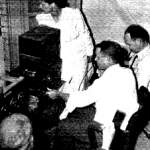
Parking lot a quarter mile from the blast. Wikipedia photo.
Saturday marks the 75th anniversary of the deadliest industrial accident in U.S. history, the Texas City disaster of April 16, 1947, which started as a fire aboard the French-registered vessel SS Grandcamp docked at Texas City, Texas, with 2200 tons of ammonium nitrate. The disaster killed at least 581 people, including all but one member of the Texas City fire department.
Smoke was spotted in the cargo hold of the Grandcamp at about 8:00 AM. The captain ordered his crew to steam the hold, which probably made matters worse by converting the ammonium nitrate to nitrous oxide.
Spectators gathered, believing that they were a safe distance away. The sealed hold began to bulge, and water splashing against the hull began to boil.
The cargo detonated at 9:12 AM, with a blast leveling over a thousand buildings on land and destroyed the Monsanto chemical plan and ignited refinery and chemical tanks on the waterfront. Bails of twine from the cargo were set afire and hurled around the city. People in Galveston, 10 miles away, were forced to their knees, and the shock wave was felt as far as 250 miles away.
The ironically named SS High Flyer was docked nearby, and the blast set fire to that ship’s cargo of ammounium nitrate. Fifteen hours later, that ship exploded.
Hams Take To The Air
As might be expected, the blast destroyed much of the city’s communication infrastructure, and amateur radio operators quickly responded to fill the gap. Many of these stories are detailed in the July 1947 issue of QST (pages 38-40).

B.H. Standley, W5FQQ, on the air at city hall, along with city clerk Ernest Smith, Nurse Mrs. E.L. Brockman.
By noon, the first amateur portable and mobile stations had moved into the city and were on the air, working in conjuction with Army, Navy, Coast Guard, U.S. Engineers, FBI, and local and state police. Links were quickly set up between City Hall and stations in Houston and San Antonio. Most traffic was handled on 75 meter phone and 80 and 40 meter CW. W5KMZ reportedly handled over 200 messages, mostly involving needed medical supplies. As the hours went on, additional traffic was handled by W5FQQ at the mayor’s office, with over 300 messages passing on behalf of city officials, the Army, Red Cross, and Salvation Army.
An impromptu three-way net was established on 3989 kHz between Texas City, Galveston, and Houston. The FCC issued an order clearing the frequencies between 3840-3860 kHz, as well as 7050 for emergency use.
Two hams, W5FQQ and W5EEX, had been advised to evacuate but remained at their stations. They narrowly escaped death when the High Flyer lived up to its name with its explosion. W5FQQ was on the air at the time of the blast, and the blast was heard by W5IGS in Houston. 21 seconds later, the Houston station experienced his windows shaking.
W1AW declared the emergency to be over 11 days later, on April 17.
Broadcasters Cover the Disaster
Broadcasters also did their part to provide emergency relief. The FCC allowed broadcast stations to carry personal messages, ordinarily not permitted by the rules. According to the April 21, 1947, issue of Broadcasting, KPRC, the Houston NBC affiliate, was the first to announce the explosion of the French ship. A mobile crew was rushed to Texas City, and the station was able to feed live descriptions of the tragedy. It also broadcasts lists of wounded at hospitals in Galveston, Houston, and other nearby towns.
Another Houston station, KTHT, similarly acted in the public interest. The Texas Highway Patrol used the station as an unofficial traffic control outlet, warning away sightseers and directing public service vehicles. The station was on the air on a 24 hour basis, and no commercials were aired for two days. In fact, when the High Flyer exploded, the sound was carried live over the station’s report.
KXYZ and KTRH in Houston, as well as KRLD Dallas broadcast emergency information.
In Galveston, KGBC aired the first bulletin minutes after the first explosion, and aired 24 remote broadcasts. Normally a daytime station, it was granted authority to broadcast 24 hours.
KLUF in Galveston also remained on the air on a 24 hour basis, with emergency messages given priority. Long lists of the dead, missing, and injured were also aired.
KPAC in Port Arthur, a station we’ve previously featured, also carried emergency announcements and instructions from police and other officials. Another Port Arther station, KOLE, chartered a plane to get newsmen to the scene.
In San Antonio, WOAI received a request from the NBC network to charger a plane, fly over the area, and report back in a broadcast from San Antonio. Their description was aired on the network broadcast that evening.
Litigation Ensues
As might be expected, considerable litigation followed, much of it under the Federal Tort Claims Act for alleged negligence of the U.S. Government. The case ultimately made its way to the U.S. Supreme Court, Dahelite v. United States, 346 U.S. 15 (1953), in which the court held that the Government was not liable, since all of the claimed government negligence amounted to discretionary acts.
